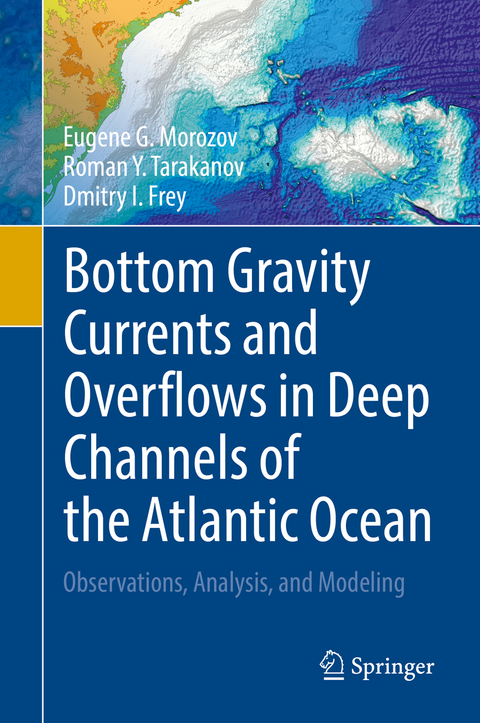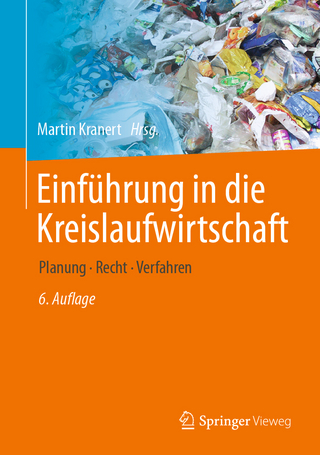
Bottom Gravity Currents and Overflows in Deep Channels of the Atlantic Ocean
Springer International Publishing (Verlag)
978-3-030-83073-1 (ISBN)
Seawater is cooled at high latitudes, descends to the ocean bottom, and slowly flows to the tropical latitudes and further. This current is slow in the deep basins, but intensifies in the abyssal channels connecting the basins. The current overflows submarine topographic structures and sometimes forms deep cataracts when water descends over slopes by several hundred meters. The flow of Antarctic Bottom Water (AABW) is studied on the basis of CTD sections combined with Lowered Acoustic Doppler Profiling (LADCP) carried out annually,and long-term moored measurements of currents.
This book is a collection of oceanographic data, interpretation, and analysis, which can be used by field oceanographers, specialists in numerical modeling, and students who specialize in oceanography.
lt;p>Eugene Morozov is Head of Laboratory of Hydrological Processes at the Shirshov Institute of Oceanology in Moscow (Russia). He has been working at this Institute after graduating from the Moscow Institute of Physics and Technology in 1970. He never changed his place of work. His research is focused on oceanic internal waves and large-scale circulation of the ocean. He is a field oceanographer and a specialist in the observations in the open ocean. He works on data acquisition, data processing, interpretations, and partly numerical modeling. Since 2002, he has been interested in the abyssal flows in the Atlantic Ocean and abyssal circulation, especially in the flows in the deep fractures. Since 2008, he has been also working on the problems of arctic oceanography in cooperation with the scientists from the University Centre in Svalbard. His interests are in the interaction of the ocean water and glaciers descending to the fjords. During his oceanographic career he participated in 47 long oceanic cruises in all oceans of the globe and in 15 coastal expeditions. His field works are related to internal tides and currents in the ocean such as the Gulf Stream, Kuroshio and their rings, Antarctic Circumpolar Current, Falkland Current, California Current, equatorial countercurrents in the Indian and Atlantic oceans. He was a guest scientist at the Woods Hole Oceanographic Institution (USA), Universidad Complutense de Madrid (Spain), Netherland Institute for Sea Research, University Center in Svalbard, Universidad de Buenos Aires, Universidad de Montevideo, Arizona State University (USA), Florida State University (USA), University of Victoria (Canada), and University of Cape Town. In 1999 he became a member of the Executive Committee of the International Association for the Physical Sciences of the Ocean (IAPSO). From 2011 to 2015 he was the President of this Association. He was also a member of the Executive Committee of the International Union of Geodesy and Geophysics (IUGG) and a member of the Executive Committee of the Scientific Council on Oceanic Research (SCOR).
Roman Tarakanov is a leading scientist of Laboratory of Oceanic Currents at the Shirshov Institute of Oceanology in Moscow (Russia). He has been working at this Institute after graduating from the Moscow Institute of Physics and Technology in 1996. He is a field oceanographer and his career developed at the Shirshov Institute of Oceanology in Moscow. He received a Ph.D. degree in 2006 and then a doctoral degree in 2015. In 2015 he became a Professor of the Russian Academy of Sciences. He works on interpretation of the field data and satellite data and methods of data processing. During his oceanographic career he participated in 21 long oceanic cruises in the Atlantic and Southern oceans. His research focuses on water masses, ocean fronts, and currents. The role of bottom topography on the formation of the oceanic circulation, investigation of the abyssal flows in the Atlantic Ocean, three-dimensional circulation in the Southern Ocean, application of satellite altimetry for correcting field measurements of currents are most important themes of his interest. He has more than 50 referenced publications and one monograph in the field of his scientific interests. Many times he participated in the international oceanographic conferences and convened sessions on the Southern Ocean. He is a professor of the Department of Oceanography at the Moscow Institute of Physics and Technology. He is lecturing for the students on the general problems of physical oceanography and supervising the research of many graduate and post-graduate students. He is also a co-author of well illustrated tutorial on the subject of his lectures.
Dmitry Frey is a senior scientist of Laboratory of Hydrological Processes at the Shirshov Institute of Oceanology in Moscow (Russia). He graduated from the Moscow Institute of Physics and Technology and got a
Foreword.- Acknowledgements.- List of Abbreviations.- Abstract of the book. Bottom gravity currents and overflows in deep channels of the Atlantic.- Preface.- Chapter 1. Deep Water Masses of the South and North Atlantic.- Chapter 2. General Overview of Abyssal Pathways, and Channels (for Waters of the Antarctic Origin).- Chapter 3. Source Regions.- Chapter 4. Exchange between the Argentine and Brazil Basins; Abyssal Pathways and Bottom Flow Channels (for Waters of the Antarctic Origin).- Chapter 5. Further Propagation of Antarctic Bottom Water from the Brazil Basin.- Chapter 6. Fractures in the Mid-Atlantic Ridge of the North Atlantic.- Chapter 7. Eastern Basin Pathways and Further Propagation of Antarctic Bottom Water in the East Atlantic.- Chapter 8. Passages in the East Azores Ridge.- Chapter 9. Flows through the Northern Channels in the North Atlantic.- Summary of Research and Integrated Conclusions.
| Erscheinungsdatum | 03.12.2021 |
|---|---|
| Zusatzinfo | XXX, 483 p. 1 illus. |
| Verlagsort | Cham |
| Sprache | englisch |
| Maße | 155 x 235 mm |
| Gewicht | 981 g |
| Themenwelt | Naturwissenschaften ► Biologie ► Ökologie / Naturschutz |
| Naturwissenschaften ► Geowissenschaften ► Geografie / Kartografie | |
| Naturwissenschaften ► Geowissenschaften ► Geologie | |
| Naturwissenschaften ► Geowissenschaften ► Hydrologie / Ozeanografie | |
| Schlagworte | Abyssal channels • Angola Basin • Atlantic Ocean • Bottom Flow Channels in the Atlantic • Boundary Currents • Brazill Basin • Charlie Gibbs Fracture Zone • CTD measurement • Deep Circulation • gravity currents • Kane Gap • North Atlantic Deep Water • numerical modeling • Overflows • Vema Fracture Zone |
| ISBN-10 | 3-030-83073-X / 303083073X |
| ISBN-13 | 978-3-030-83073-1 / 9783030830731 |
| Zustand | Neuware |
| Informationen gemäß Produktsicherheitsverordnung (GPSR) | |
| Haben Sie eine Frage zum Produkt? |
aus dem Bereich


